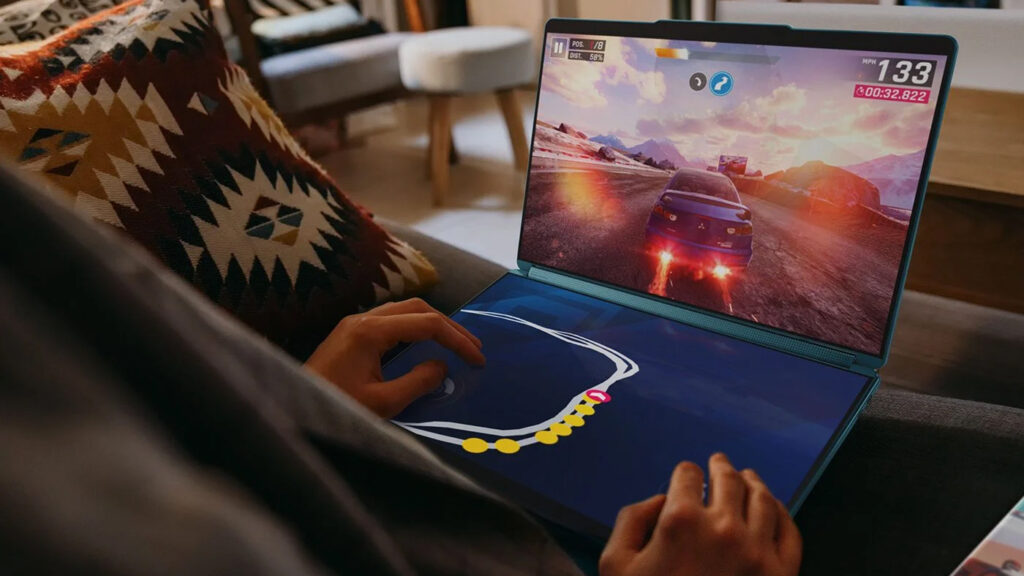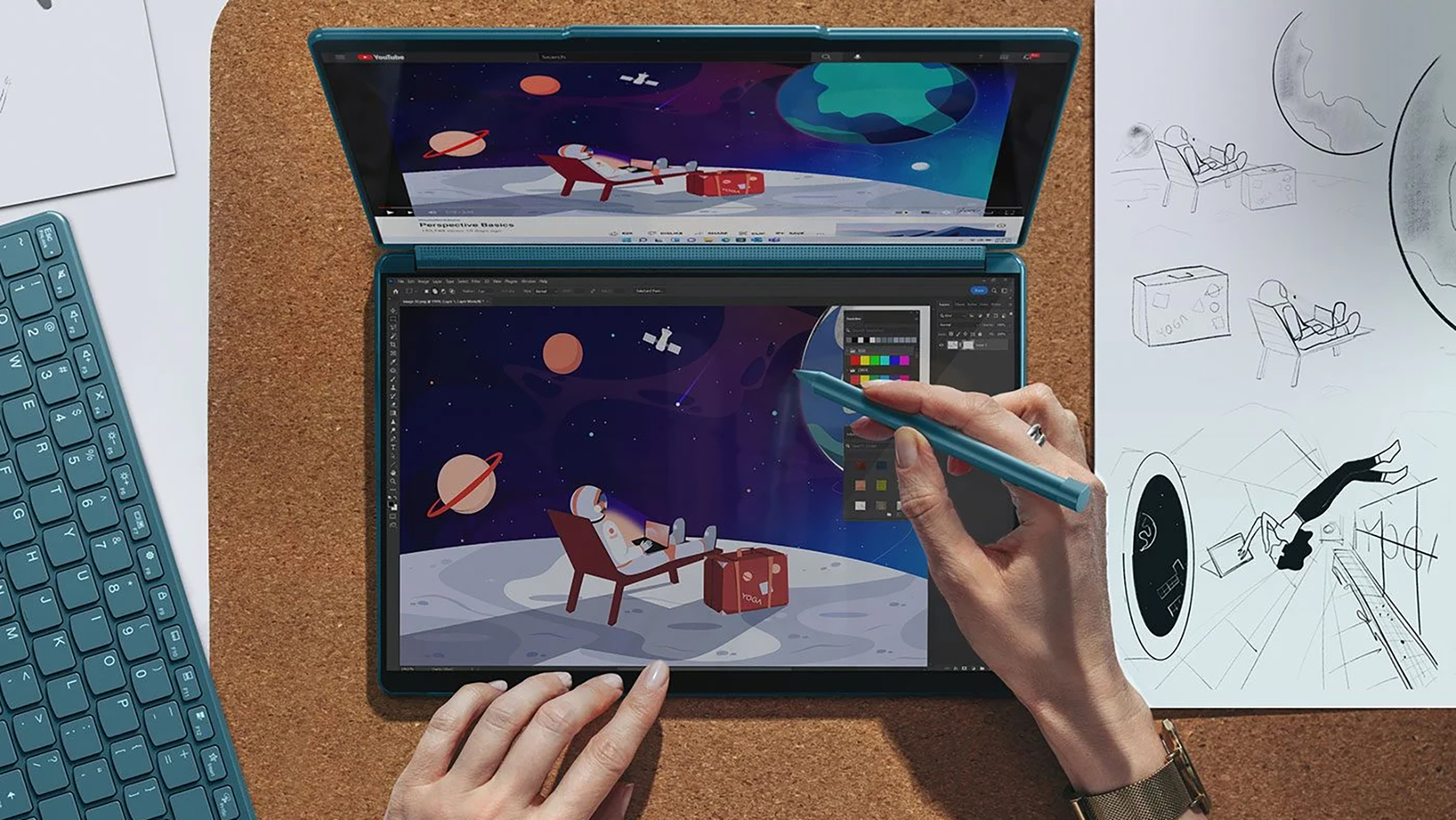Why settle for one screen when you can have two? This is undoubtedly the question Lenovo asked itself when designing its Yoga Book 9i.
To say the Yoga Book 9i isn’t your average laptop would be an understatement. Where most manufacturers are content to connect a screen and a keyboard with a hinge, Lenovo has decided to innovate with a laptop made up of two screens. A configuration to say the least original, almost unpublished, but which could seem gadget at first sight.
It is not so. Behind this Yoga Book 9i hides a strong concept. A versatile device, dedicated to productivity, capable of bending to your every need, and which also pays for the luxury of offering above-average user comfort. Presented at the last edition of CES (where it had also intrigued the editorial staff of Numerama), the Yoga Book 9i is now available in all shelves.
Yoga Book 9i: versatility according to Lenovo
” How to create a modern, practical PC, capable of adapting to the needs of all workers? »
Lenovo probably asked this question before creating the Yoga Book 9i. His answer ? A laptop consisting of two screens connected by a hinge capable of rotating 180 degrees, and completed by a magnetic keyboard and a stylus. A form-factor little used, but which has nevertheless proven itself in terms of versatility and productivity.
This dual screen configuration allows the Yoga Book 9i to adopt many forms, eight in total, which correspond to as many different uses. This is enough to provide a practical answer to the problems posed by the turpitudes of modern professional life. Whatever your need, chances are Lenovo’s creation can meet it.
In its simplest configuration, the Yoga Book 9i looks like a classic laptop. The magnetic keyboard is positioned on the bottom screen, revealing part of the slab which then acts as a trackpad. A second option is however possible by installing the keyboard against the lower border of the second screen, so as to benefit from a sort of improved taskbar. It is also possible to completely dispense with the magnetic keyboard in favor of a virtual keyboard displayed on the lower screen.
Like many 2-in-1 PCs, the Yoga Book 9i also has a presentation mode (for a single-screen display) and a tent mode. The latter is more interesting insofar as it allows a display on both sides. You can also decide to completely fold the computer in order to use it as a touch pad.
As its name suggests, the Yoga Book 9i can also be used as a book. Its thin design (barely 15 mm), its limited weight (1.34 kg on the scale) and its edges designed with this in mind provide a comfortable grip over time. Combined with the stylus, this mode makes it easy to annotate a document or take notes.
But, the real advantage of this dual screen is undoubtedly to offer an extended display. A real need for many users, and which is dealt with here in an exhaustive manner. The Yoga Book 9i can adopt two different dual screen configurations:
- a vertical mode, ideal for reading documents and taking notes, but which will also work wonders for developers who need to display pages of code;
- a horizontal mode which allows you to have the two screens one above the other thanks to the foldable support provided (which also serves to protect the keyboard during transport). Enough to enjoy a comfortable workspace with a minimal footprint.
Why settle for one OLED screen when you can have two?
When creating a laptop with two screens, it is better to insure on the panels that you choose to install. And, from that perspective, Lenovo hasn’t been kidding the world. Its Yoga Book 9i has two 13.3-inch OLED touch screens. The manufacturer has also chosen to swap the usual 21:9 format for a more comfortable 21:10 format, appreciated by many professionals.

If the brightness (400 cd / m2) and the refresh rate are fairly standard for this type of machine, the compatibility with the Dolby Vision HDR standard and the 100% coverage of the DCI-P3 gamut are more interesting. Enough to obtain a clear display, with faithful color rendering, which will not fail to delight image professionals, graphic designers or videographers.
A solid technical sheet to accompany you on a daily basis
In order to allow the Yoga Book 9i to fulfill its promise of versatility, Lenovo had to put together a technical sheet with a delicate balance between power and energy savings. The presence of two screens is far from trivial in terms of the device’s power consumption and autonomy, a point that should not be overlooked when offering a mobile device.
The manufacturer’s choice therefore fell on the Core i7-1355U, a 13th generation low-power processor (15W), ideal for machines of this type (thin and oriented towards productivity). An Intel Iris Xe graphics processor (for very light gaming), 16 GB of RAM and storage between 512 GB and 1 TB complete the package. Enough to obtain quite correct performance for productivity, but a little tight for the most demanding graphics applications.

Rounding out that spec sheet, and providing pros with all the tools they might need, the Yoga Book 9i has a 1080p webcam, three Thunderbolt 4 ports, and is Wi-Fi 6E and Bluetooth 5.2 compatible. Available since June 19, this laptop like no other is currently sold for 2,699 euros in its 512 GB version, and 2,799 euros in its 1 TB version.
Some links in this article are affiliate. We’ll explaine everything here.
This is content created by freelance writers within the Humanoid xp entity. Numerama’s editorial team did not participate in its creation. We are committed to our readers to ensure that this content is interesting, qualitative and corresponds to their interests.
